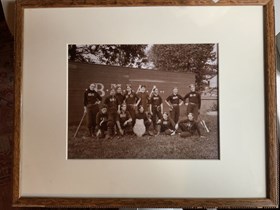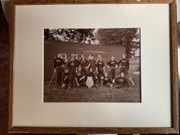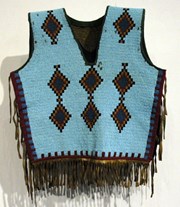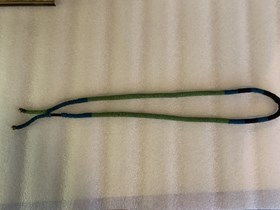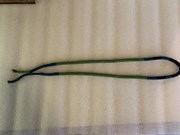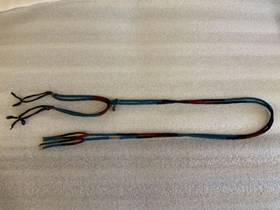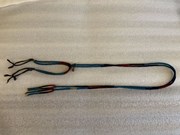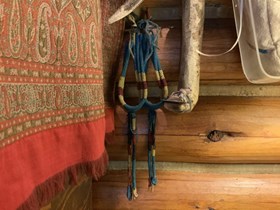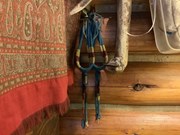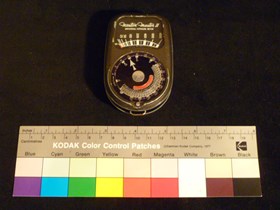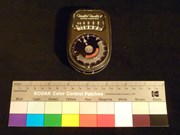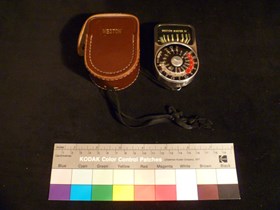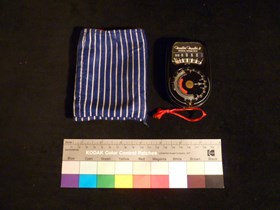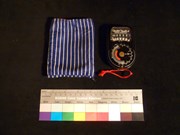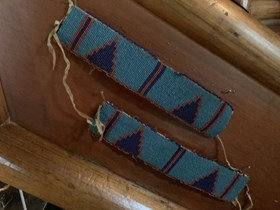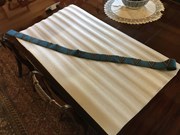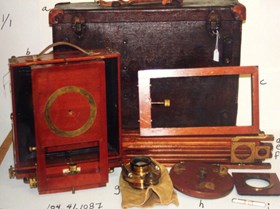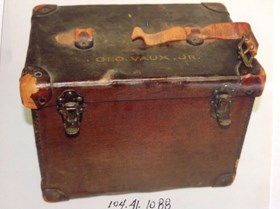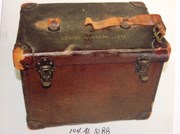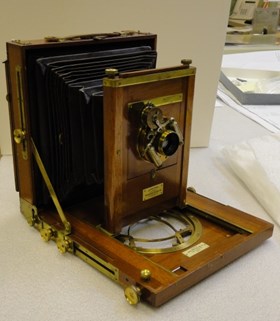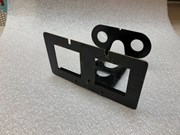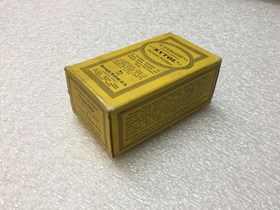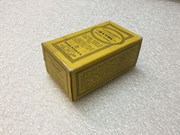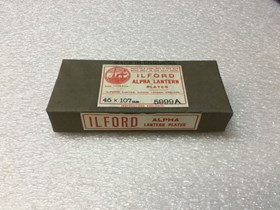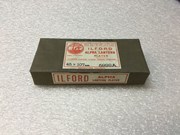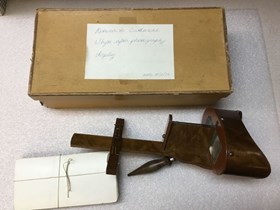Narrow Results By
Photographic Print
https://archives.whyte.org/en/permalink/artifact105.02.0050
- Date
- 1897 – 1897
- Material
- paper; wood; glass; metal
- Catalogue Number
- 105.02.0050
- Description
- A black and white photograph of a baseball team dressed in striped socks, padded knickers, and shirts with “BMI” on the front. There is a young man in the centre at the back dressed in a U.S. Union Army military uniform. The team is grouped around a chest pad which reads "BMI 17 Rutgers 7 97" and …
1 image
- Title
- Photographic Print
- Date
- 1897 – 1897
- Material
- paper; wood; glass; metal
- Dimensions
- 17.5 (image); 30.0 (frame) x 22.0 (image); 37.5 (frame) cm
- Description
- A black and white photograph of a baseball team dressed in striped socks, padded knickers, and shirts with “BMI” on the front. There is a young man in the centre at the back dressed in a U.S. Union Army military uniform. The team is grouped around a chest pad which reads "BMI 17 Rutgers 7 97" and they are standig in front of a high board fence with 'BMIAA' painted on it. The photograph is framed in a narrow oak frame with carved dot trim along the edge, a split wood backing, one screw eye and hanging wire, and scraps of brown backing paper are attached.
- Subject
- photography
- education
- Boston Military Institute
- Rutgers University
- athletics
- sports, baseball
- Credit
- Gift of Pearl Evelyn Moore, Banff, 1979
- Catalogue Number
- 105.02.0050
Images
This material is presented as originally created; it may contain outdated cultural descriptions and
potentially offensive content.
Read more.
- Date
- 1895
- Material
- skin, buffalo; glass; fabric
- Catalogue Number
- 103.05.0003
- Description
- An entirely beaded boy's vest with fringe along both of the sides and the bottom. The vest has blanket trim and a v-neck. The vest is decorated with nine diamond motifs of red and blue beads forming a square on the back, and six diamonds centred on the front and two on the front shoulders. The en…
1 image
- Title
- Beaded Vest
- Date
- 1895
- Material
- skin, buffalo; glass; fabric
- Dimensions
- 42.0 x 55.0 (includes 9.0 cm fringe) cm
- Description
- An entirely beaded boy's vest with fringe along both of the sides and the bottom. The vest has blanket trim and a v-neck. The vest is decorated with nine diamond motifs of red and blue beads forming a square on the back, and six diamonds centred on the front and two on the front shoulders. The entire vest is beaded with a light blue background.
- Credit
- Gift of Pearl Evelyn Moore, Banff, 1979
- Catalogue Number
- 103.05.0003
Images
This material is presented as originally created; it may contain outdated cultural descriptions and
potentially offensive content.
Read more.
Beaded Necklace
https://archives.whyte.org/en/permalink/artifact103.01.0014
- Date
- 1890
- Material
- fibre; glass; metal
- Catalogue Number
- 103.01.0014
- Description
- A thick necklace formed by wrapping a strand of small glass beads around a length of cloth with one large brass metal bead at each end. The small beads are black, blue, and green, attached in colour-block sections along the length of the necklace. The two ends of the length of cloth are beaded tog…
1 image
- Title
- Beaded Necklace
- Date
- 1890
- Material
- fibre; glass; metal
- Dimensions
- 57.0 cm
- Description
- A thick necklace formed by wrapping a strand of small glass beads around a length of cloth with one large brass metal bead at each end. The small beads are black, blue, and green, attached in colour-block sections along the length of the necklace. The two ends of the length of cloth are beaded together so the necklace forms a loop.
- Subject
- decorative
- Indigenous
- Stoney
- beadwork
- regalia
- Credit
- Gift of Pearl Evelyn Moore, Banff, 1979
- Catalogue Number
- 103.01.0014
Images
This material is presented as originally created; it may contain outdated cultural descriptions and
potentially offensive content.
Read more.
Beaded Necklace
https://archives.whyte.org/en/permalink/artifact103.01.0001
- Date
- 1890
- Material
- glass; fibre
- Catalogue Number
- 103.01.0001
- Description
- A necklace made of two thick strands wrapped with dark blue and red beads. Hanging from the centre of the necklace there are two thick ropes of wrapped beads which split into two pieces at each end. Cotton ribbons secure the necklace at the neck.
1 image
- Title
- Beaded Necklace
- Date
- 1890
- Material
- glass; fibre
- Dimensions
- 150.0 cm
- Description
- A necklace made of two thick strands wrapped with dark blue and red beads. Hanging from the centre of the necklace there are two thick ropes of wrapped beads which split into two pieces at each end. Cotton ribbons secure the necklace at the neck.
- Subject
- Indigenous
- Stoney
- decorative
- beadwork
- regalia
- Credit
- Gift of Pearl Evelyn Moore, Banff, 1979
- Catalogue Number
- 103.01.0001
Images
This material is presented as originally created; it may contain outdated cultural descriptions and
potentially offensive content.
Read more.
- Date
- 1890
- Material
- glass; fibre
- Catalogue Number
- 103.01.0003 a,b
- Description
- A pair of armlets, each consisting of three thick strands wrapped with stripes of dark blue, yellow and red beads. Two wrapped strands hang from the centre of each armlet with loops of beads at the ends and where they attach.
1 image
- Title
- Beaded Armlet
- Date
- 1890
- Material
- glass; fibre
- Dimensions
- 32.5 cm
- Description
- A pair of armlets, each consisting of three thick strands wrapped with stripes of dark blue, yellow and red beads. Two wrapped strands hang from the centre of each armlet with loops of beads at the ends and where they attach.
- Subject
- Indigenous
- Stoney
- beadwork
- regalia
- Credit
- Gift of Pearl Evelyn Moore, Banff, 1979
- Catalogue Number
- 103.01.0003 a,b
Images
This material is presented as originally created; it may contain outdated cultural descriptions and
potentially offensive content.
Read more.
Exposure Meter
https://archives.whyte.org/en/permalink/artifact104.41.1118
- Date
- 1888
- Material
- metal; paint; plastic
- Catalogue Number
- 104.41.1118
- Description
- Hand held exposure/light meter made by Weston Electrical Instrument Company in a grey metal finish. Along both sides of the meter are a series of protruding lines that allow one to safely grip the object. At the bottom of the artifact there is a metal hook, which would have allowed a string to be a…
1 image
- Title
- Exposure Meter
- Date
- 1888
- Material
- metal; paint; plastic
- Dimensions
- 2.0 x 6.0 x 9.5 cm
- Description
- Hand held exposure/light meter made by Weston Electrical Instrument Company in a grey metal finish. Along both sides of the meter are a series of protruding lines that allow one to safely grip the object. At the bottom of the artifact there is a metal hook, which would have allowed a string to be attached like on the other Weston meter’s owned by Nicholas. There is also no longer a case to protect this particular object. In the top of the exposure meter there is a clear plastic covering. Along the very top there us the name of the manufacturer in white cursive lettering that reads “Weston Master II” and written underneath in capital letters “UNIVERSAL EXPOSURE METER.” Below this is the light scale where the value of the scene would be indicated. The scale contains the values “0” “25” “50” “100” “200” “400” “800” “1600,” which means that the two values on this instrument are calibrated 0-50 and 0-1600. (candles per square foot.)Below there is a circular face with several figures and a dial that turns/rotates. The outside row of figures on the exposure control dial represents the light value settings and corresponds to the light values on the light scale. Below the round dial there is a tiny circular button that is used to set the exposure control dial for film speed. As the dial turns it reveals the “EMULSION SPEED” with a red baize finish that has become worn throughout its life. The row of figures at the bottom of the top dial is the f/stop values and has an “f” to make this more apparent for the user. The row of figures directly below the f/stop settings are the shutter speeds. After setting the exposure control dial to the light value obtained on the light scale, any of the combinations of f/stop and shutter speed directly opposite each other are correct. On the rear of the meter there is a black plastic covering that contains several circular cut outs that are called a hir.ged baffle. This can be swung open (against the case) using the gold latch, which clips into a tiny hole or socket when the user wishes it to be closed. When opened the light sensitive photo cell is directly beneath this baffle and contains several protruding circles. When the baffle is open, the scale range is 0-50; when the baffle is closed, the scale range is 0-1600. Below there is an oval shaped face with extensive information that is held in place with two small screws on both the viewer left and right side. There is silver lettering on a black background that reads “WESTON ELEC. INST. CORP.” “NEWARK, N.J., U.S.A.” A silver backing separates the patent information and has black writing that reads “MODEL 735” on the viewer left side. On the viewer right side the number “7454510” is engraved. In the middle there is a gold-coloured screw with the words “ZERO CORRECTOR” written in black. Below this there is the patent information; “U.S. PATENTS” “2,274,441” “2,073,790” “2,346,555” “2,137,466” “2,463,770.” Below these numbers are the “FOREIGN PATENTS” “FRENCH 862,770” “BRITISH 531,996” “CAN. 347,085” “CAN. 411,975” At the very bottom underneath there is the manufacturer’s location; “MADE IN U.S.A.”
- Subject
- photography
- Nick Morant
- Credit
- Gift of Nicholas Morant, Banff, 2006
- Catalogue Number
- 104.41.1118
Images
This material is presented as originally created; it may contain outdated cultural descriptions and
potentially offensive content.
Read more.
- Date
- 1888
- Material
- leather; metal; nylon; plastic; thread; paint
- Catalogue Number
- 104.41.1119 a-b
- Description
- Hand held light meter in a pear shape with a stainless steel body and leather case. Along both sides of the meter are a series of protruding lines that allow one to safely grip the object. On the viewer right there is a pointer lock, which is locked when positioned upwards and released when positio…
1 image
- Title
- Exposure Meter
- Date
- 1888
- Material
- leather; metal; nylon; plastic; thread; paint
- Dimensions
- 2.0 x 5.0 x 9.0 cm
- Description
- Hand held light meter in a pear shape with a stainless steel body and leather case. Along both sides of the meter are a series of protruding lines that allow one to safely grip the object. On the viewer right there is a pointer lock, which is locked when positioned upwards and released when positioned downward. At the bottom of the artifact there is a metal hook, which has a black string running through. In the top of the light meter there is clear plastic covering. Written in capital letters is “WESTON MATER IV” above the light scale. The lights scale contains the numbers “0” “25” “50” “100” “200” “400” “800” “1600,” which means that the 2 values calibrated on this instrument are 0-50 and 0-1600.Below there is another light scale in the form of a circular face with several figures and a dial that turns/rotates. The dial on the outside has a series of protruding lines to make movement easier and contains a row of figures. This dial controls the lens aperture (f/stop) scale and has a series of values representing the focal length of the lens; “1” “1.4” “2” “2.8” “4” “5.6”. On the same dial there is also the letters “EVS,” which stands for the exposure value setting with a cut out window that reveals the EVS values. Working in a clockwise direction (on the same dial) there is also the letters “U,” “A with “1/2” over top,” an enclosed arrow that is known as the normal arrow, a “C” with “2x” on top of it, and a “0”. As this dial is turned it reveals a partly red baize and black numbers on a silver background that represents the shutter speeds in fractions of seconds. The inside dial has a series of light scale values and an exposure index window that line up with the “U,” “A,” normal arrow, “C,” and “0.” On the opposite side of the exposure index window is the exposure index knob. On the rear of the meter there is a black plastic covering that contains several circular cut outs that are called a hir.ged baffle. This can be swung open (against the case) using the gold latch, which clips into a tiny hole or socket when the user wishes it to be closed. When opened the light sensitive photo cell is directly beneath this baffle and contains several protruding circles. When the baffle is open, the scale range is 0-50; when the baffle is closed, the scale range is 0-1600. Below there is an oval shaped face with extensive information that is held in place with two small screws on both the viewer left and right side. There is black lettering on a silver background that reads “UNIVERSAL EXPOSURE METER” “MODEL 745” SER.W” and “107522” engraved. Below the manufacturer information is listed; “DAYSTROM. INCORPORATED” “WESTON INSTRUMENTS DIVISION”. “NEWARK. N.J.. U.S.A.” In the middle there is a gold-coloured screw with the words “ZERO CORRECTOR” written in black. On the viewer left side of the zero corrector there is patent information; “U.S. PATENTS” “2463770” and on the viewer right side “FOREIGN PATS” “CAN. 411975”. At the very bottom on either side of a circular cut out are “ASA” and “K=1.0” written. Underneath “MADE IN JAPAN” has also been written.There is also a brown leather case with this object. The front has “WESTON” written in gold letters. On the viewer left there is a brown button that allows the case to be opened or fastened shut. The leather has been stitched together with light brown thread that is visible. The bottom of the case has an opening for the black string to be strung through so that the light meter and case are attached. On the rear there is a brown leather strap stitched.
- Subject
- photography
- Nick Morant
- Credit
- Gift of Nicholas Morant, Banff, 2006
- Catalogue Number
- 104.41.1119 a-b
Images
This material is presented as originally created; it may contain outdated cultural descriptions and
potentially offensive content.
Read more.
- Date
- 1888
- Catalogue Number
- 104.41.1120 a-b
- Description
- Hand held light meter in a pear shape with a stainless steel body and leather case. Along both sides of the meter are a series of protruding lines that allow one to safely grip the object. At the bottom of the artifact there is a metal hook, which has a red string running through.There is a clear p…
1 image
- Title
- Exposure Meter
- Date
- 1888
- Description
- Hand held light meter in a pear shape with a stainless steel body and leather case. Along both sides of the meter are a series of protruding lines that allow one to safely grip the object. At the bottom of the artifact there is a metal hook, which has a red string running through.There is a clear plastic covering located at the top of the meter. Written in cursive letters is the company name “WESTON MATER II”. Underneath this written in capital letters is “UNIVERSAL EXPSOURE METER”. The light scale underneath contains the numbers “0” “25” “50” “100” “200” “400” “800” “1600,” which means that the 2 values calibrated on this instrument are 0-50 and 0-1600. Underneath the scale the word “Light” is present. Below there is another light scale in the form of a circular face with several figures and a dial that turns/rotates. The outside row of figures on the exposure control dial represents the light value settings and corresponds to the light values on the light scale at the top. The row of figures at the bottom of the top dial is the f/stop values and has an “f” to make this more apparent for the user.. On the same dial there is silver letters that have a line that correspond to the figures on the outside dial; “U,” “A with “1/2” underneath,” an arrow that is known as the normal arrow, a “C” with “2x” below it, and a “0”. As this dial is turned it reveals a partly red baize and the emulsion speed, which is self-evident as the words “EMULSION SPEED” are present. The row of figures directly below the f/stop settings are the shutter speeds. The outside row of figures is the light values, which is apparent as the word “LIGHT” with an arrow points to these values. After setting the exposure control dial to the light value obtained on the light scale, any of the combinations of f/stop and shutter speed directly opposite each other are correct. Below the round dial there is a tiny circular button that is used to set the exposure control dial for film speed.On the rear of the meter there is a black plastic covering that contains several circular cut outs that are called a hir.ged baffle. This can be swung open (against the case) using the gold latch, which clips into a tiny hole or socket when the user wishes it to be closed. When opened the light sensitive photo cell is directly beneath this baffle and contains several protruding circles. When the baffle is open, the scale range is 0-50; when the baffle is closed, the scale range is 0-1600. Below there is an oval shaped face with extensive information that is held in place with two small screws on both the viewer left and right side. There is silver lettering on a black background that reads “WESTON ELEC. INST. CORP.” “NEWARK, N.J., U.S.A.” A silver backing separates the patent information and has black writing that reads “MODEL 735” on the viewer left side; “No” is present in the middle; “8284703” is engraved on the viewer right side. In the middle there is a brass screw with the words “ZERO CORRECTOR” written in black around its circumference. On the viewer left side of the zero corrector is the patent information; “U.S. PATENTS” “1,779,574” “1,982,406” “2,073,790” and on the viewer right side continued patent information “U.S. PATENTS” “2,137,466” “2,274,441” “2,346,555”. Below these numbers are the “FOREIGN PATENTS” “FRENCH 862,770” “BRITISH 531,996” “CAN. 347,085” “CAN. 411,975” At the very bottom underneath there is the manufacturer’s location; “MADE IN U.S.A.” written in black on a silver background.There is also a blue case with white stripes and a red inner lining that would be used to protect the case. This would not have been originally sold with the exposure meter and was most likely hand made in an effort to protect the meter. Blue stitches hold the fabric together and are visible.
- Subject
- photography
- Nick Morant
- Credit
- Gift of Nicholas Morant, Banff, 2006
- Catalogue Number
- 104.41.1120 a-b
Images
This material is presented as originally created; it may contain outdated cultural descriptions and
potentially offensive content.
Read more.
- Date
- 1880
- Material
- skin; glass
- Catalogue Number
- 103.01.0019 a,b
- Description
- A pair of beaded leather armlets. The design on each armlet is a turquoise background with vertical stripes and two stepped triangular shapes done in dark blue and red beads. There is scalloped beadwork around the edges, and thong ties at each end.
1 image
- Title
- Beaded Armbands
- Date
- 1880
- Material
- skin; glass
- Dimensions
- 29.0 cm
- Description
- A pair of beaded leather armlets. The design on each armlet is a turquoise background with vertical stripes and two stepped triangular shapes done in dark blue and red beads. There is scalloped beadwork around the edges, and thong ties at each end.
- Subject
- Stoney Nakoda
- beadwork
- crafts
- decorative
- indigenous
- Credit
- Gift of Pearl Evelyn Moore, Banff, 1979
- Catalogue Number
- 103.01.0019 a,b
Images
This material is presented as originally created; it may contain outdated cultural descriptions and
potentially offensive content.
Read more.
- Date
- 1880
- Material
- skin; glass
- Catalogue Number
- 103.01.0022
- Description
- Two long strips of beaded leather sewn together end to end. The pattern on the stip is a medium blue background with orange Vs outlined in black along its length.
1 image
- Title
- Beaded Trim
- Date
- 1880
- Material
- skin; glass
- Dimensions
- 7.5 x 196.0 cm
- Description
- Two long strips of beaded leather sewn together end to end. The pattern on the stip is a medium blue background with orange Vs outlined in black along its length.
- Credit
- Gift of Pearl Evelyn Moore, Banff, 1979
- Catalogue Number
- 103.01.0022
Images
This material is presented as originally created; it may contain outdated cultural descriptions and
potentially offensive content.
Read more.
- Date
- 1890 – 1905
- Material
- fibre; paper; skin; metal; glass; wood
- Catalogue Number
- 104.41.1087 a-k
- Description
- Large format 6 1/2” x 8 1/2” folding wooden field view camera (b) with brass fittings marked “IMPROVED EMPIRE STATE. MANUFACTURED BY ROCHESTER OPTICAL CO. ROCHESTER, N.Y.” With collapsable wood and brass tripod legs (d,e,f) marked “FOLMER & SCHWING MFG. CO. NEW YORK. CROWN No. 2. PAT. JUNE 23, 1903…
1 image
- Title
- View Camera
- Date
- 1890 – 1905
- Material
- fibre; paper; skin; metal; glass; wood
- Dimensions
- 40.0 x 47.0 cm
- Description
- Large format 6 1/2” x 8 1/2” folding wooden field view camera (b) with brass fittings marked “IMPROVED EMPIRE STATE. MANUFACTURED BY ROCHESTER OPTICAL CO. ROCHESTER, N.Y.” With collapsable wood and brass tripod legs (d,e,f) marked “FOLMER & SCHWING MFG. CO. NEW YORK. CROWN No. 2. PAT. JUNE 23, 1903”, wood and brass tripod top (h), small level marked “C.E. JENNINGS & CO. NEW YORK” (j), spare camera rack (c), and black light safe hood (k). Brass and glass lens in a soft leather bag (g) marked: “6 1/2 x 8 1/2 PLASTIGMAT. Pat. Oct. 30, 1900. Bausch & Lomb Optical Co. Rochester, N.Y. 359514” & “20859”. Aperture dial stamped: “BAUSCH & LOMB OPT. CO. PAT. JAN. 8, 1891. NEW YORK. ROCHESTER, N.Y. CHICAGO.” Lens in soft chamois pouch. All items fit inside brown fabric covered hard case (a) with leather reinforced corners, marked: “GEO. VAUX, JR.”
- Subject
- photography
- Vaux family
- Credit
- Gift of Molly Vaux, New York, USA, 1999
- Catalogue Number
- 104.41.1087 a-k
Images
This material is presented as originally created; it may contain outdated cultural descriptions and
potentially offensive content.
Read more.
- Date
- 1890 – 1900
- Material
- wood; metal; plastic; fibre; skin; paper
- Catalogue Number
- 104.41.1088 a-k
- Description
- Ten wooden plateholders (a-j) individually numbered, some stamped: “ROCHESTER OPTICAL CO. PAT. JULY 29, 1890”. All plateholders fit inside brown fabric covered hard case (k) with leather reinforced corners, marked: “GEO. VAUX, JR.”
1 image
- Title
- Plateholder
- Date
- 1890 – 1900
- Material
- wood; metal; plastic; fibre; skin; paper
- Dimensions
- 23.0 x 30.0 cm
- Description
- Ten wooden plateholders (a-j) individually numbered, some stamped: “ROCHESTER OPTICAL CO. PAT. JULY 29, 1890”. All plateholders fit inside brown fabric covered hard case (k) with leather reinforced corners, marked: “GEO. VAUX, JR.”
- Subject
- photography
- Vaux family
- Credit
- Gift of Molly Vaux, New York, USA, 1999
- Catalogue Number
- 104.41.1088 a-k
Images
This material is presented as originally created; it may contain outdated cultural descriptions and
potentially offensive content.
Read more.
- Date
- 1890 – 1905
- Material
- wood; metal; fibre; glass; skin
- Catalogue Number
- 104.41.1089 a-i
- Description
- Large format 6 1/2” x 8 1/2” folding wooden field view camera (a) with brass fittings, marked: “CARLTON. Manufactured by ROCHESTER OPTICAL CO. Rochester, N.Y. PAT. AUG. 31, 1886”. Another plate reads: “Bought of CHEYNEY-HOOD PHOTO. SUPPLY CO. 1006 FILBERT ST., PHILA.” With collapsable wood and bras…
1 image
- Title
- View Camera
- Date
- 1890 – 1905
- Material
- wood; metal; fibre; glass; skin
- Dimensions
- 35.0 x 64.0 cm
- Description
- Large format 6 1/2” x 8 1/2” folding wooden field view camera (a) with brass fittings, marked: “CARLTON. Manufactured by ROCHESTER OPTICAL CO. Rochester, N.Y. PAT. AUG. 31, 1886”. Another plate reads: “Bought of CHEYNEY-HOOD PHOTO. SUPPLY CO. 1006 FILBERT ST., PHILA.” With collapsable wood and brass tripod legs (f,g,h), one lens filter in leather box (e), a red photographic notebook (d), one optical finder/plate-reading magnifying glass (c), and a brass and glass lens (b) marked: “BAUSCH & LOMB OPT. CO. PAT. JAN. 6, 1891. ROCHESTER, N.Y., NEW YORK CITY. 9703.” Lens in soft chamois pouch. All items fit inside khaki canvas covered hard case (i) with leather strap mounts. Two canvas straps hold case closed.
- Subject
- photography
- Vaux family
- Credit
- Gift of Molly Vaux, New York, USA, 1999
- Catalogue Number
- 104.41.1089 a-i
Images
This material is presented as originally created; it may contain outdated cultural descriptions and
potentially offensive content.
Read more.
- Date
- 1883 – 1926
- Material
- cardboard; metal; glass;
- Catalogue Number
- 104.41.0129 a,b
- Description
- Two camera lenses housed in a repurposed Hammond box with “OLD ‘ADON’ Telephoto in shutter circa 1990’s” written in black ink on the front.The larger lens with shutter was manufactured by Bausch & Lomb Optical Co., originally a company that produced prescription eye-wear in the mid to late-1800s be…
1 image
- Title
- Camera Lenses
- Date
- 1883 – 1926
- Material
- cardboard; metal; glass;
- Dimensions
- 5.7 x 7.8 x 14.5 cm
- Description
- Two camera lenses housed in a repurposed Hammond box with “OLD ‘ADON’ Telephoto in shutter circa 1990’s” written in black ink on the front.The larger lens with shutter was manufactured by Bausch & Lomb Optical Co., originally a company that produced prescription eye-wear in the mid to late-1800s before expanding into camera lenses and microscopes/telescopes towards the turn of the century. The company was founded in Rochester NY.The smaller lens was manufactured by Gundlach-Manhattan Optical Co., a merged company between Gundlach Optical Co. and Manhattan Optical Co. that took place in 1902, which produced various kinds of bellows cameras. Both companies were based in Rochester NY prior to merging.
- Credit
- Gift of Nicholas Morant, Banff, 2006
- Catalogue Number
- 104.41.0129 a,b
Images
This material is presented as originally created; it may contain outdated cultural descriptions and
potentially offensive content.
Read more.
- Date
- 1893 – 1930
- Material
- metal; glass;
- Catalogue Number
- 105.05.0035
- Description
- Black metal folding stereoscope. The rectangular frame has two square openings that allow light to pass through the image, which is inserted into tracks on the inside of the frame. Opposite the rectangular frame is a rounded frame containing two round glass lenses that also has a rounded cut-out wh…
1 image
- Title
- Stereoscope
- Date
- 1893 – 1930
- Material
- metal; glass;
- Dimensions
- 7.1 x 13.5 x 7.5 cm
- Description
- Black metal folding stereoscope. The rectangular frame has two square openings that allow light to pass through the image, which is inserted into tracks on the inside of the frame. Opposite the rectangular frame is a rounded frame containing two round glass lenses that also has a rounded cut-out where the nose can fit. Between the two frames is an adjustable plate, allowing the image to be moved further from or closer to the viewer in order to be brought into focus. The stereoscope folds in on itself and latches with a small gold flat-top peg that fits into a small slot on the lens frame.
- Subject
- Crosby family
- Abegweit
- photography
- stereoscopes
- Credit
- Gift of Robert Crosby Family, Banff, 1998
- Catalogue Number
- 105.05.0035
Images
This material is presented as originally created; it may contain outdated cultural descriptions and
potentially offensive content.
Read more.
Photograph Developer
https://archives.whyte.org/en/permalink/artifact104.41.0203
- Date
- 1880 – 1940
- Material
- cardboard;
- Catalogue Number
- 104.41.0203
- Description
- Empty cardboard box of Burroughs Wellcome & Co. ‘Tabloid’ (Photographic) ‘Rytol’ Universal Developer that could be used on plates, film, bromide and gaslight papers, and glass lantern slides. Directions on how to use the developer are printed in black throughout the yellow box. Developers were eith…
1 image
- Title
- Photograph Developer
- Date
- 1880 – 1940
- Material
- cardboard;
- Dimensions
- 9.0 x 4.0 x 5.1 cm
- Description
- Empty cardboard box of Burroughs Wellcome & Co. ‘Tabloid’ (Photographic) ‘Rytol’ Universal Developer that could be used on plates, film, bromide and gaslight papers, and glass lantern slides. Directions on how to use the developer are printed in black throughout the yellow box. Developers were either chemical powders or liquids that would be added to another agent [usually a bath] to create a solution that would then be used to expose the positive photograph after it had been transferred from the original negative. Different concentrations or chemicals used could yield different results, usually in regards to contrast and colour of the finished image, depending on the photographic base.
- Credit
- Gift of Robert Crosby Family, Banff, 1998
- Catalogue Number
- 104.41.0203
Images
This material is presented as originally created; it may contain outdated cultural descriptions and
potentially offensive content.
Read more.
Lantern Plates
https://archives.whyte.org/en/permalink/artifact104.41.0206
- Date
- 1889 – 1910
- Material
- paper; glass;
- Catalogue Number
- 104.41.0206
- Description
- One paper-wrapped package of 45x107mm Ilford Alpha Lantern Plates with white and red paper adhesive labels on the top and front of the package containing manufacturer details. These lantern plates would serve as the positive mount for the lantern slide made from the original negative. Lantern slide…
1 image
- Title
- Lantern Plates
- Date
- 1889 – 1910
- Material
- paper; glass;
- Dimensions
- 2.0 x 11.6 x 5.3 cm
- Description
- One paper-wrapped package of 45x107mm Ilford Alpha Lantern Plates with white and red paper adhesive labels on the top and front of the package containing manufacturer details. These lantern plates would serve as the positive mount for the lantern slide made from the original negative. Lantern slides are glass-based transparencies that were displayed by being projected through an early projector called a magic lantern. Starting as hand-painted images on glass, lantern slides quickly adapted to first black-and-white and then colour photography and faded from popularity with the rise of celluloid film and motion pictures.
- Credit
- Gift of Robert Crosby Family, Banff, 1998
- Catalogue Number
- 104.41.0206
Images
This material is presented as originally created; it may contain outdated cultural descriptions and
potentially offensive content.
Read more.
- Date
- 1883 – 1979
- Material
- cardboard; wood; metal;
- Catalogue Number
- 105.05.0040 a,b
- Description
- Wooden hand-held stereoscope with a long base along which the card frame can slide, goggle-shaped lens housing that blocks out light around the sides, two square lenses angled slightly towards the center, a central blocker, and a pointed fold-down handle. The card frame is a separate piece that sli…
1 image
- Title
- Stereoscope
- Date
- 1883 – 1979
- Material
- cardboard; wood; metal;
- Dimensions
- 10.1 x 33.5 x 16.0 cm
- Description
- Wooden hand-held stereoscope with a long base along which the card frame can slide, goggle-shaped lens housing that blocks out light around the sides, two square lenses angled slightly towards the center, a central blocker, and a pointed fold-down handle. The card frame is a separate piece that slides on and off the end of the long base and features two wire holders that fold out to fit the card. Also includes a stack of manufactured stereoscope cards that mostly feature scenes from Palestine and the United States that have spots of colour tinting, possibly hand-applied. Everything is housed in a cardboard shoe box with a white “COES & STODDER” sticker on one short side. Written on one short side of the lid is “STEREOPTICAN” in black ink and taped to the lid is a piece of paper that reads “Return to Catharine Whyte after photograph display” signed and dated by Maryalice Stewart 14 February 1979.
- Subject
- souvenir
- commemorative
- photography
- Credit
- Gift of Catharine Robb Whyte, O. C., Banff, 1979
- Catalogue Number
- 105.05.0040 a,b
Images
This material is presented as originally created; it may contain outdated cultural descriptions and
potentially offensive content.
Read more.
- Date
- 1890 – 1900
- Material
- cardboard;
- Catalogue Number
- 110.01.0293 a-c
- Description
- Three empty boxes for one Transparent Film Cartridge meant to be used in the Kodak No. 2 Bullet Camera - each cartridge could take twelve 3 1/2 inch exposures. Each box has a black and white paper label adhered across the top of the lid with the product and manufacturer details printed throughout -…
1 image
- Title
- Film Box
- Date
- 1890 – 1900
- Material
- cardboard;
- Dimensions
- 3.8 x 4.0 x 10.3 cm
- Description
- Three empty boxes for one Transparent Film Cartridge meant to be used in the Kodak No. 2 Bullet Camera - each cartridge could take twelve 3 1/2 inch exposures. Each box has a black and white paper label adhered across the top of the lid with the product and manufacturer details printed throughout - on the bottom is a white and red paper label with a warning to develop the film before May 1st, 1900. All three boxes have various kinds of writing throughout the exteriors - two have notes written on one long side in pencil by Russell Robb [most likely Catharine’s father].
- Subject
- photography
- photographic developing
- film
- Credit
- Gift of Catharine Robb Whyte, O. C., Banff, 1979
- Catalogue Number
- 110.01.0293 a-c
Images
This material is presented as originally created; it may contain outdated cultural descriptions and
potentially offensive content.
Read more.
- Date
- c. 1900
- Material
- wood; metal; glass
- Catalogue Number
- 104.41.0243
- Description
- A folding wooden camera with gold metal features. When folded the main body of the camera lens is set into the centre of the wooden frame surrounded by a circular opening with a metal circle that is able to twist [where the tripod would attach]. The camera opens from a hinge to fold out, releasing …
1 image
- Title
- Wooden Camera
- Date
- c. 1900
- Material
- wood; metal; glass
- Description
- A folding wooden camera with gold metal features. When folded the main body of the camera lens is set into the centre of the wooden frame surrounded by a circular opening with a metal circle that is able to twist [where the tripod would attach]. The camera opens from a hinge to fold out, releasing the black bellows, the front with the camera lens is on hinges that allow the camera lens to be propped up from the front frame that protected it. There are hinges to secure the position of the lens, there is also knobs and gears to operate the camera and a fibre cord with a metal ring attached to the bottom of the lens. On the base of the frame (which protects the lens when folded), features knobs that can twist to extend the length of the bellows, this part of the frame is inlaid in the base. On the back of the camera is another frame with a glass insert that is held in place with a clasp and on hinges. Along the side of this part of the camera are knobs on hinges to support when the bellows are extended further and inlaid is a white circle label which reads “THE Sandringham REG.” in brown text.
- Credit
- Gift of L. A. E Duncan, Calgary, 1980
- Catalogue Number
- 104.41.0243
Images
This material is presented as originally created; it may contain outdated cultural descriptions and
potentially offensive content.
Read more.

